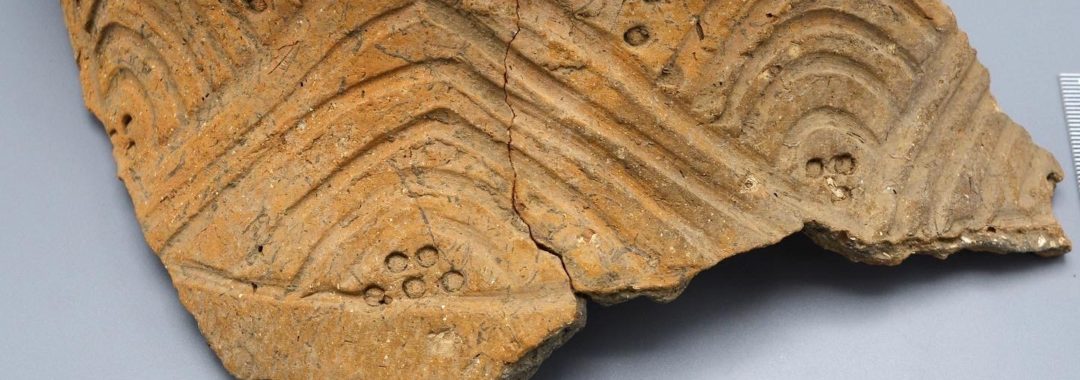
CMC Blog
What’s in a Pot? Lessons from Native American Pottery
By: Bob Genheimer, George Rieveschl Curator of Archaeology
Because most Native American pottery we discover through excavations or surface collections is broken into small pieces called sherds, people often ask us “what can those pieces tell us?” As it turns out quite a lot! By focusing on clues such as what’s on the surface, what part of the entire pot it is, how it is tempered and even how it broke, archaeologists can learn quite a bit.
The first thing that a ceramic analyst looks at is the temper material. Most fired clay pottery requires the use of a tempering agent (small, solid pieces of material) to mitigate the effects of heat and shrinkage on the clay. Native Americans used a variety of tempering materials during the roughly two millennia that they fired clay vessels. In general, the earliest tempers consisted of ground pieces of rock such as igneous or metamorphic rock, sand and even limestone. While rock is a fine temper, and worked well during firing and use, pots with rock temper tend to be fragile, and hence break easily, often into small sherds. Beginning at about AD 1000, Native Americans started using crushed freshwater bivalve shells to temper their pots. At first, they added rock to the shell mixture, but gradually through time, shell alone became the preferred temper. Because shell is lenticular (in thin lenses), thinner and stronger pots could be made.
Surface treatment, “or, what have they done to the outside of the vessel?” is the next thing a ceramic analyst examines. Pot surfaces are generally plain (unfinished except for smoothing), cordmarked (often called corded or cord roughened) or decorated. Plain pots are not as common as cordmarked ones, but most pots will exhibit a combination of plain and cordmarked zones, such as a plain neck with a cordmarked body. Knowing how local vessels are typically treated, the analyst can determine which part of the pot is present. Cordmarking roughens the surface for easier handling (think of how many times you have dropped a smooth dish when it is wet), and also allows for better transfer of heat to the pot when cooking.
Because pottery is a plastic medium, the range of possible decorations is endless, although most Native American groups adhered to a smaller range of decorative techniques. At Late Precontact villages (ca. 1000-1650 CE) near Cincinnati, we see several major decorative groups including variations of guilloche (a ribbon pattern circling a pot neck) (Figure 1), line-filled triangles (nested triangles below the rim) (Figure 2), punctates (shallow punched holes) (Figure 3), short incising (such as chevrons or slashes on a rim) (Figure 4) and fingernail impressions (often on the lip of the rim).
And, lastly, pottery analysts look for clues to ascertain the part of the vessel. Generally, sherd types are divided into body, rim and appendage categories. If you drop a vessel, breaking it into many pieces, you will find that the vast majority will be body sherds, with a smaller number of rim sherds and even a smaller number of appendage or handle sherds (Figure 5). Knowing these frequencies can help you estimate the number of vessels.

Figure 1. Incised curvilinear guilloche design on vessel neck, Late Precontact.

Figure 2. Incised line-filled triangle design on vessel with cordmarking below, Late Precontact.

Figure 3. Punctates on rim fold and punctates and incising on neck, Late Precontact.

Figure 4. Slashes on rim fold with punctates and incising on neck, Late Precontact.

Figure 5. A loop handle (L) and a fluted strap handle (R), Late Precontact.
Museum Admission
Includes Cincinnati History Museum, Museum of Natural History & Science and The Children's Museum
| Adult: | $22.50 |
| Senior: | $15.50 |
| Child: | $15.50 |
| Member Adult: |
FREE |
| Member Child: |
FREE |
Members receive discounts!
Become a Member today to save on programs, exhibits and films throughout CMC.
Museum Hours
Open Thursday – Monday
10 a.m. to 5 p.m.
Closed Tuesday and Wednesday
Closed Thanksgiving Day and Christmas Day
Member’s-only early entry: Saturdays at 9 a.m.
Customer Service Hours:
Monday – Sunday, 9 a.m. to 5 p.m.

